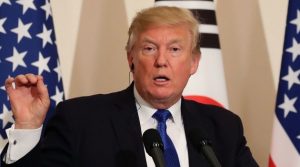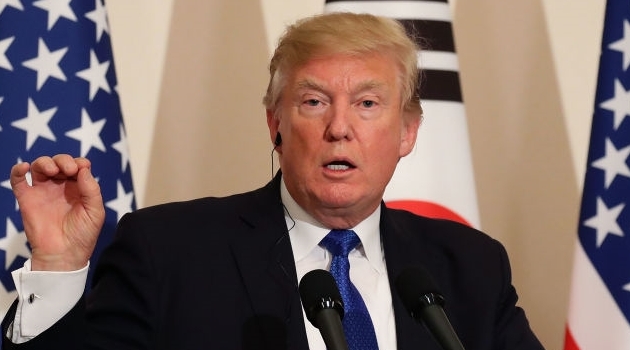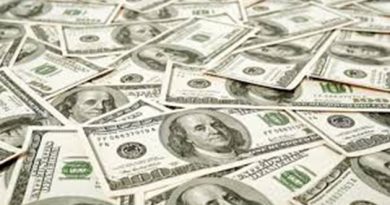Trump is Getting Nowhere with Europe and China on Widening Trade Deficits

President Donald Trump repeated earlier this month his frequent complaint that the “the U.S. has been ripped off by other countries for years on trade,” but he omitted to mention that the “ripping off” process continues — on his watch.
Here is what’s happening to U.S. trade accounts under Trump’s stewardship: Last year, America’s deficit on goods trade widened to $810 billion, marking an annual increase of 7.6 percent, after a 1.3 percent decline in 2016.
That trade deterioration was partly due to the economy’s accelerating growth to 2.3 percent from 1.5 percent in 2016. Still, despite Trump’s promises, there was no narrowing of deficits with any of America’s main trade partners. In fact, particularly large deficit increases were noted last year with Mexico, Canada and China — in that order of importance.
So far this year, the trade gap looks much worse. In the first four months, the deficit was 10.1 percent above its year-earlier level. Over the same period, the trade gaps with the European Union and China widened at annual rates of 17.5 percent and 11.6 percent, respectively. The trade deficit with Japan also increased 5.3 percent.
Trade-challenged Trump
Again, some of the continuing deterioration of trade accounts is owed to America’s considerably faster growth in the last two quarters. But that also shows that U.S. trade policy is unable to plug the soaring leakages of the huge fiscal and monetary stimulation of domestic demand.
That must be infuriating to the president who stakes his credibility on keeping the promises made about major policy objectives. The entire external sector of the American economy is getting worse because China, the European Union and Japan seem unwilling to allow the U.S. to reduce its unsustainably large trade deficits in an orderly manner.
Those three economies account for nearly 75 percent of America’s $810 billion deficit, but they are still accusing Washington of protectionism and destruction of the multilateral trading system.
That attitude is something one could expect from China, but not from presumably friendly allies like the European Union and Japan.
For China, at issue is 4.1 percent of its total demand and output — a share of exports to the U.S. in China’s nominal GDP. Apart from that, there are structural problems requiring massive adjustments in China’s manufacturing sectors that have been set up, with the help of U.S. investments and technology, as a world’s export powerhouse.
Washington’s trade and economic policy dialogue with China is also very difficult in an atmosphere of sensitive security considerations. China is a country that Washington defines as a “strategic competitor” and a “revisionist power” intent on changing the Western (i.e., American) world order.
At the same time, ongoing military confrontations about China’s contested maritime borders, and Washington’s diplomatic gestures toward Taiwan, perceived by Beijing as another challenge to its territorial integrity, are not an auspicious background for confident agreements on half-a-trillion-dollar trade issues.
Washington also made things difficult for itself by allowing the problem to slip into the meanders of contentious and slow-moving technical negotiations.
Kick up the trade agenda
The problem should have been kept at the highest level of state, where it is easily understood that China’s $375 billion annual trade surplus with the U.S. is unacceptably large. A consensus would then follow for a prompt and steady action to balance the bilateral trade books.
Had things been done that way, it would have been politically impossible for Beijing to maintain a belligerent attitude of being “locked and loaded” for a trade war while its surpluses with the U.S. continue to soar at annual rates of 12 percent.
It might still be possible to push the trade issue with China back to Trump’s agenda of key national security considerations. That’s probably what China expects because Trump originally linked up bilateral trade imbalances with Korean nukes and other East Asian problems.
Trump seems to have successfully tested that approach at the G-7 summit last week by impressing the European leaders to take his trade warnings seriously.
Germans were the first to respond. With the external sector accounting for 84 percent of the economy, Berlin always keeps trade issues at the top of the state’s agenda. So, to tone down the European trade rhetoric with Washington, and to make tangible progress on rebalancing trade accounts, Berlin is now setting up a special EU group to deal with American trade transactions.
Interestingly, Germany is considerably raising its purchases of American products. In the first four months of this year, U.S. exports to Germany soared 11.7 percent. That is double the rate of increase of U.S. exports to Japan, and four percentage points above the increase of American sales to China.
Germans appear to be deeply worried by rumors that Trump intends to put heavy import duties on automobiles. Partly as a result of that, Germans have now become the main advocates of a calm and thoughtful approach to trans-Atlantic relations, and seem ready to work with Washington on improving access of American businesses to EU markets.
Washington expects that Japan will take the same approach in dismantling its formidable barriers to entry for American car manufacturers and a broad range of U.S. consumer goods industries. Japanese Prime Minister Shinzo Abe had a refresher chat about that from Trump in a separate meeting on the way to the G-7 summit. As the president would say, let’s see what happens.
Investment thoughts
The EU, China and Japan are complaining about the alleged U.S. protectionist policies while continuing to accumulate large surpluses on their American trades.
That is unacceptable, unsustainable and very dangerous for world trade and asset markets. Unless those surpluses begin to narrow radically in the months ahead, Washington will be pushed to introduce restrictive trade measures.
Driven by a large fiscal stimulus and accommodative monetary policies, the U.S. economy is poised to remain on a growth path of about 3 percent for the rest of this year. Rising corporate sales and subdued unit labor costs bode well for profits and equity prices.
courtesy : CNBC
photo : WowKeren.com
[social_warfare buttons=”Facebook,Pinterest,LinkedIn,Twitter,Total”]



